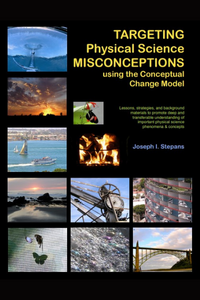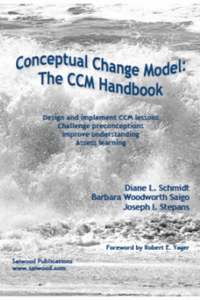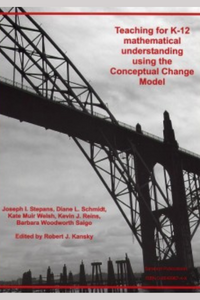Description
Author: Joseph I. Stepans
For classroom teachers, teacher preparation courses, and home schooling
CCM lessons use a 6-phase, constructivism-based strategy. The approach reveals and challenges students’ existing ideas about physical science phenomena and concepts. Students learn through inquiry and interaction, experience conceptual change, and develop deep understanding they are able to transfer to other situations.
Topics and Contents
Each chapter describes common preconceptions, misconceptions and points of confusion about specific concepts, provides background information for the teacher, and presents a set of CCM lessons to target students’ existing ideas.
- Misconceptions and Conceptual Change: An Introduction
- Matter
- Density and Buoyancy
- Air Pressure
- Liquids
- Force, Work, and Machines
- Levers
- Motion
- Pendulums
- Electricity
- Magnetism
- Mental Model Building
- Heat
- Waves
- Sound
- Light and Color
- Transformation of Energy
- More Abstract Concepts
- Planning for Additional Topics
- Appendices
Bonus Section
Using the CCM in other subject areas, with sample lessons from mathematics, social studies, and language arts. Using structured interviews to learn what students really think as a basis for designing and assessing instruction.
Reviews from Users of the Book
“I would like to offer a few words of praise for Joe Stepans’ book and curriculum approach. It has been a wonderful improvement over some traditional methods. The results while using this approach have been the most successful I’ve seen in my seven-year career. My students and I have never been more enthusiastic towards class. Congratulations to Dr. Stepans for making an exciting and engaging science course available to virtually anyone willing to implement it.” (Ron Foresman, Science and Biology Teacher, Vero Beach Jr. High School)
“This book systematically applies current science education research to classroom instruction. It is an invaluable guide for middle level and high school physical science teachers. I also believe that it would serve as an excellent resource for preservice science teachers.” (Charles R. Barman, Professor of science Education, School of Education, Indiana University)
“I believe this book demonstrates to teachers how to facilitate learning and how to enable the student to learn through first-hand experience. The activities included are very user friendly and are ones that students will find of interest. The conceptual change strategy is clearly and succinctly discussed in the text as a method of presenting the science concepts to students. … This has been and will continue to be a book I recommend to friends and acquaintances who are educators.” (Sarah E. Fuller, Elementary Education Major, University of Wyoming)
“Dr. Stepans changed our focus from teaching to learning. We now ask ourselves, ‘What are our students learning?’ This simple shift has energized the curriculum at our school.” (Carol T. Marino, Principal, Osceola Magnet School)
“The most wonderful result of using this model is observing my students as they think about their predictions and ponder their results. My students and I are asking more questions and I am answering less. I love taking time with units and letting students develop a real understanding of concepts.” (Diane L. Schmidt, Elementary Teacher, Franklin Park Magnet School)



